Not many travelers make it to Sukhothai, the former capital of what is now Thailand, whose kingdom is remembered as a golden age. This city is located 450 km from Bangkok and 300 km from Chiang Mai, meaning a few hours of driving, even though it has its own airport.
However, over the years, it has become one of our favorite places in the country after visiting it several times with friends and family and having the opportunity to cycle through all its small corners. If you’re planning to include this city in your itinerary, this is your travel guide.
Founded by King Ramkhamhaeng after a revolt against Khmer rule, Sukhothai, or the “Dawn of Happiness” as its name implies, became the first capital of what is now Thailand in the 13th century.
He extended his power into the Malay Peninsula, west into what is now Myanmar (Burma), and northeast into present-day Laos. After his death in 1298, the kingdom began to lose power, and in 1438, it was absorbed into the Ayutthaya Kingdom.
Today, the ruins of the old city are known as the Sukhothai Historical Park and are a UNESCO World Heritage Site. For years, it was the main city of the Sukhothai Kingdom until it gave way to the Ayutthaya Kingdom, whose city became the second capital.
Sukhothai is located in northern Thailand, so you’ll experience three distinct seasons influenced by the monsoon:
![]() Travel advice: Check out our article on the best time to visit Thailand for month-by-month climate information.
Travel advice: Check out our article on the best time to visit Thailand for month-by-month climate information.
To begin with, we always recommend getting good travel insurance Thailand. This can save you a significant amount on medical expenses and, most importantly, ensures that the insurance covers the costs upfront, so you don’t have to pay out of pocket.
In the previous article, we go into more detail about healthcare in Thailand, as well as tips on how to get the best insurance (and save money).
Nowadays, finding hotels, guesthouses, or restaurants in Thailand with free Wi-Fi is pretty common. However, there are still those who prefer (or need) to stay connected at all times.
That’s why we’ll show you how to get an eSIM Thailand card with internet— now also available with unlimited data.
The bus is the most accessible way to reach Sukhothai, despite the long hours if you’re coming from major cities.
Prices and travel times vary depending on the company, amenities, and the number of stops. Buses often make rest and food stops along the way.
Buses depart from several popular destinations:
Bangkok Airways operates a couple of flights daily to Sukhothai: one in the morning at 7:00 am and another in the afternoon around 4:00 pm.
If you prefer traveling by train, you can take one from Bangkok (Hua Lamphong Station) to Phitsanulok, and from there, catch a bus to Sukhothai (+1 hour).
remain. The entrance fee is 100 baht, plus an additional fee for vehicles. The area spans around 3 km² and is very easy to explore by bike.
Below are the three most important temples, though you’ll find many more along the paths between them.
Surrounded by a 206-meter-long wall, Wat Maha That, built in the 13th century, is the largest temple in Sukhothai. It contains nearly 200 chedis and many Buddha images.
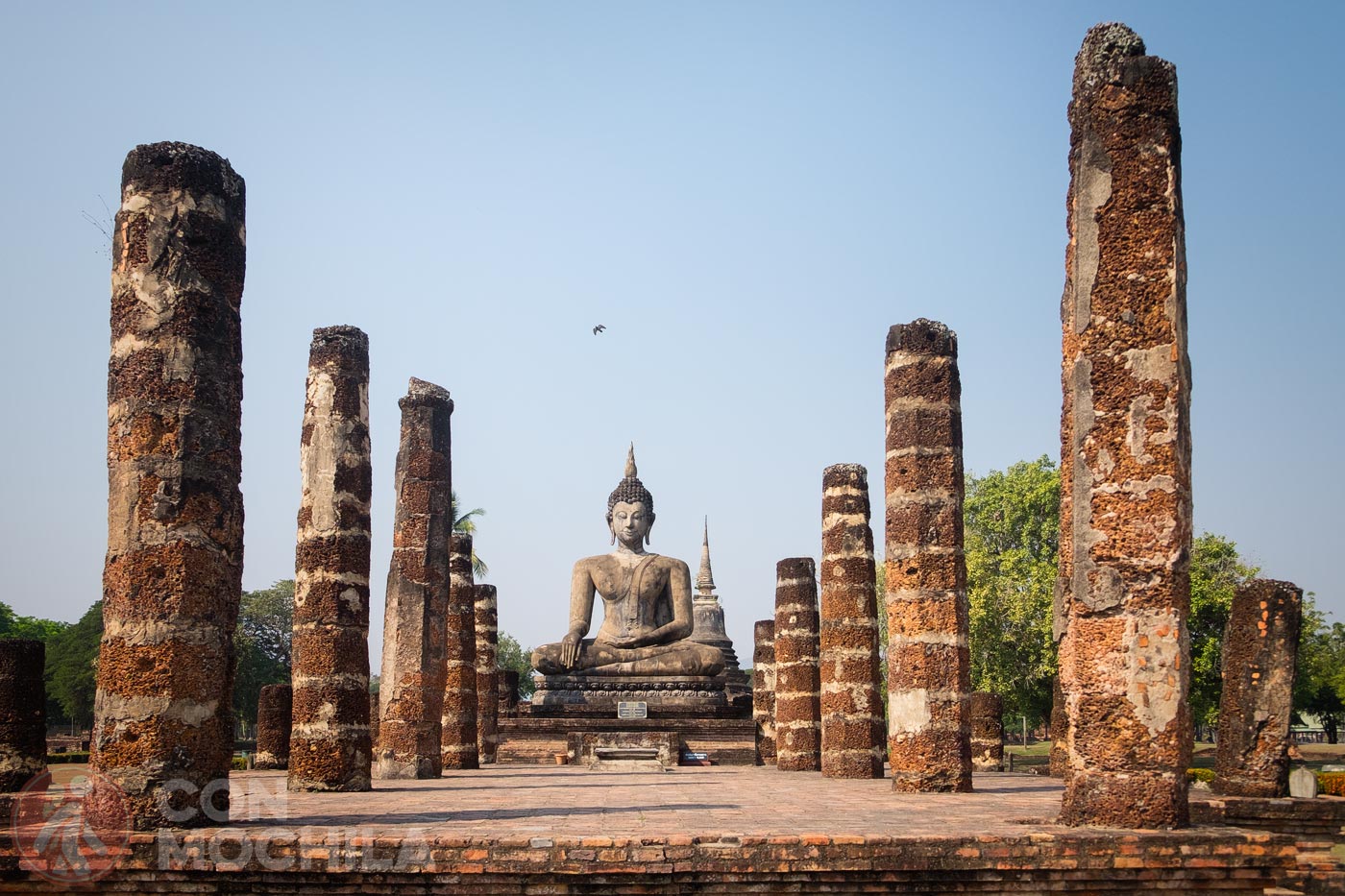
Its size, significance, and central location within the walled city make it one of the most visited by tourists. One of the most photographed spots is the prayer hall, where a large Buddha image is displayed.
Another beautiful temple within the walls is Wat Sa Si, or the “Monastery of the Sacred Pond.” It features a chedi, a Buddha statue, and the remains of wihaan columns.
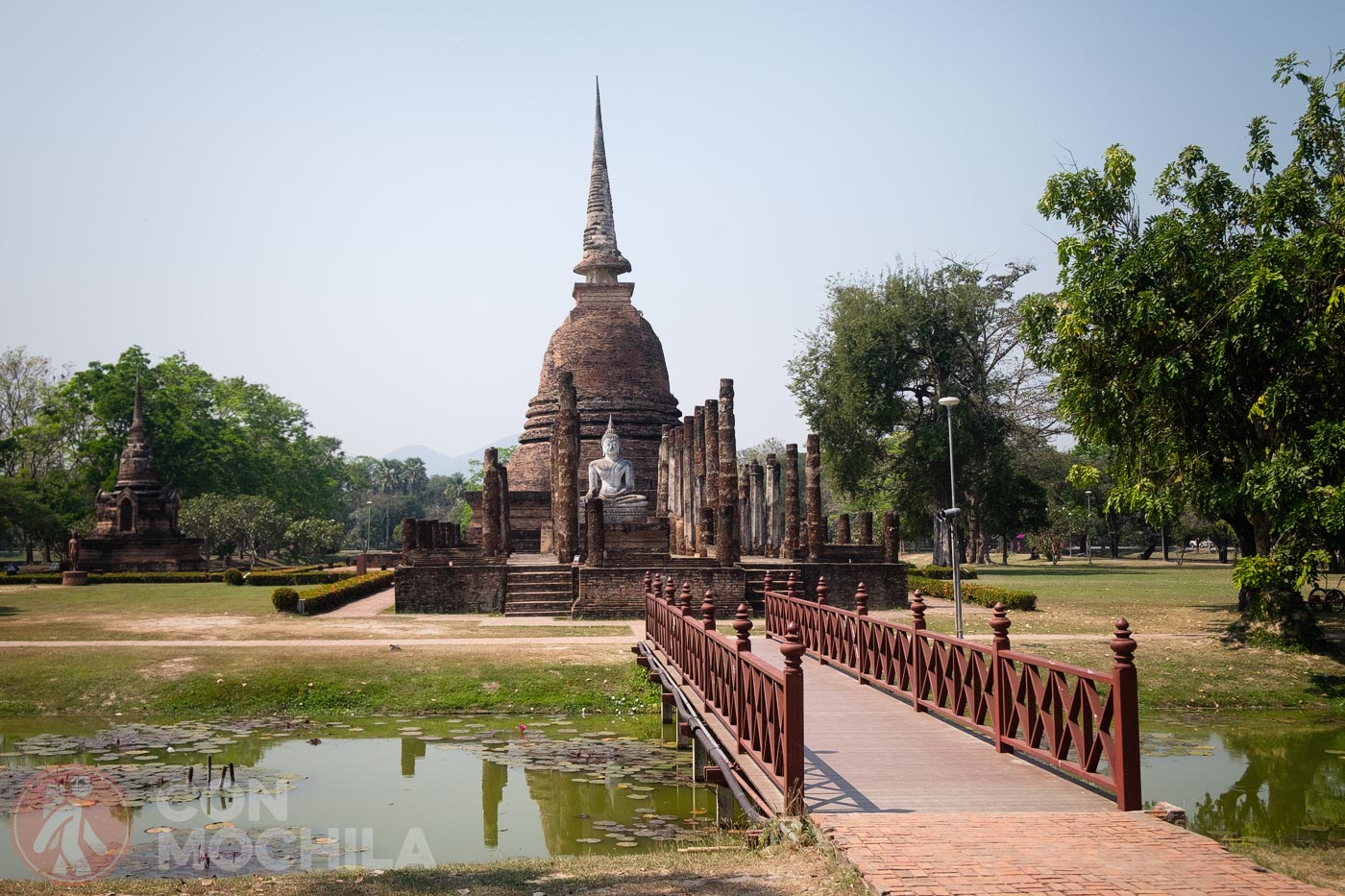
In front of the stupa, there’s a walkway across the pond offering the best view. There’s also a quiet rest area where you can relax after some cycling.
Built by the Khmers in the 12th or 13th century as a Hindu temple dedicated to Shiva, it is easily recognizable by its style and three prangs (towers), especially if you’ve visited the temples of Angkor, as it may remind you of Bayon. During the Sukhothai reign, it was converted into a Buddhist temple.
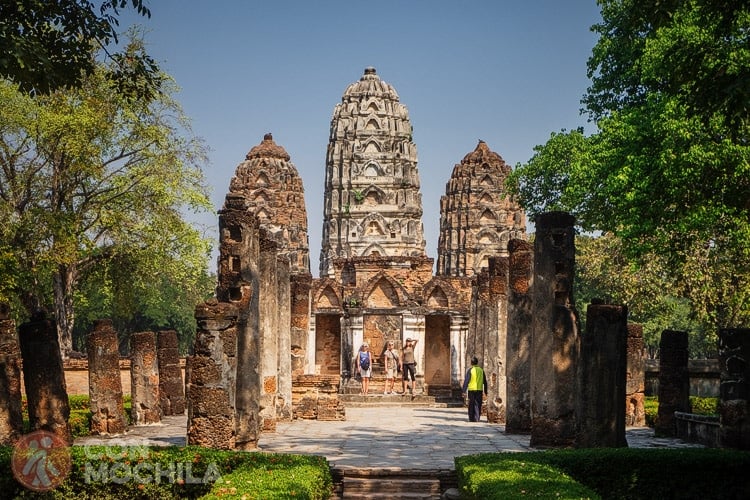
It’s one of the oldest temples in the Historical Park and is located south of Wat Maha That.
There are four temple zones outside the walls, located at the cardinal points. Below are the main temples in each zone (East, North, West, and South). Keep in mind that the North and West zones require an additional entrance fee of 100 baht each.
One of the first temples you will come across as you arrive on the east side of the old city is Wat Traphang Thong Lang. It’s quite unique and easy to recognize by the pond filled with lotus flowers and hungry fish surrounding it.
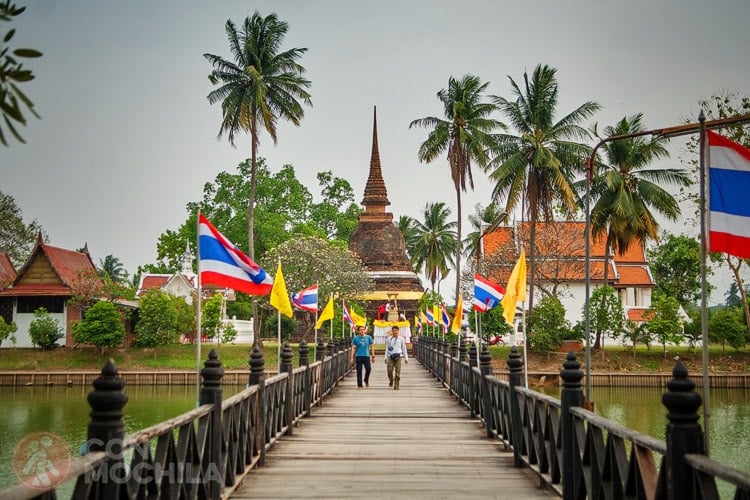
A very photogenic wooden walkway leads inside, where an old stupa and a large Buddha footprint greet visitors. It is one of the most photographed temples (very popular on Instagram), and entry is free, so it’s definitely worth seeing.
Located in the northern part of the walled city, Wat Si Chum is easily accessible by bike. It houses a huge and spectacular 15-meter-high Buddha statue hidden between four walls. Nearby is Wat Phra Phai Luang, surrounded by a moat.
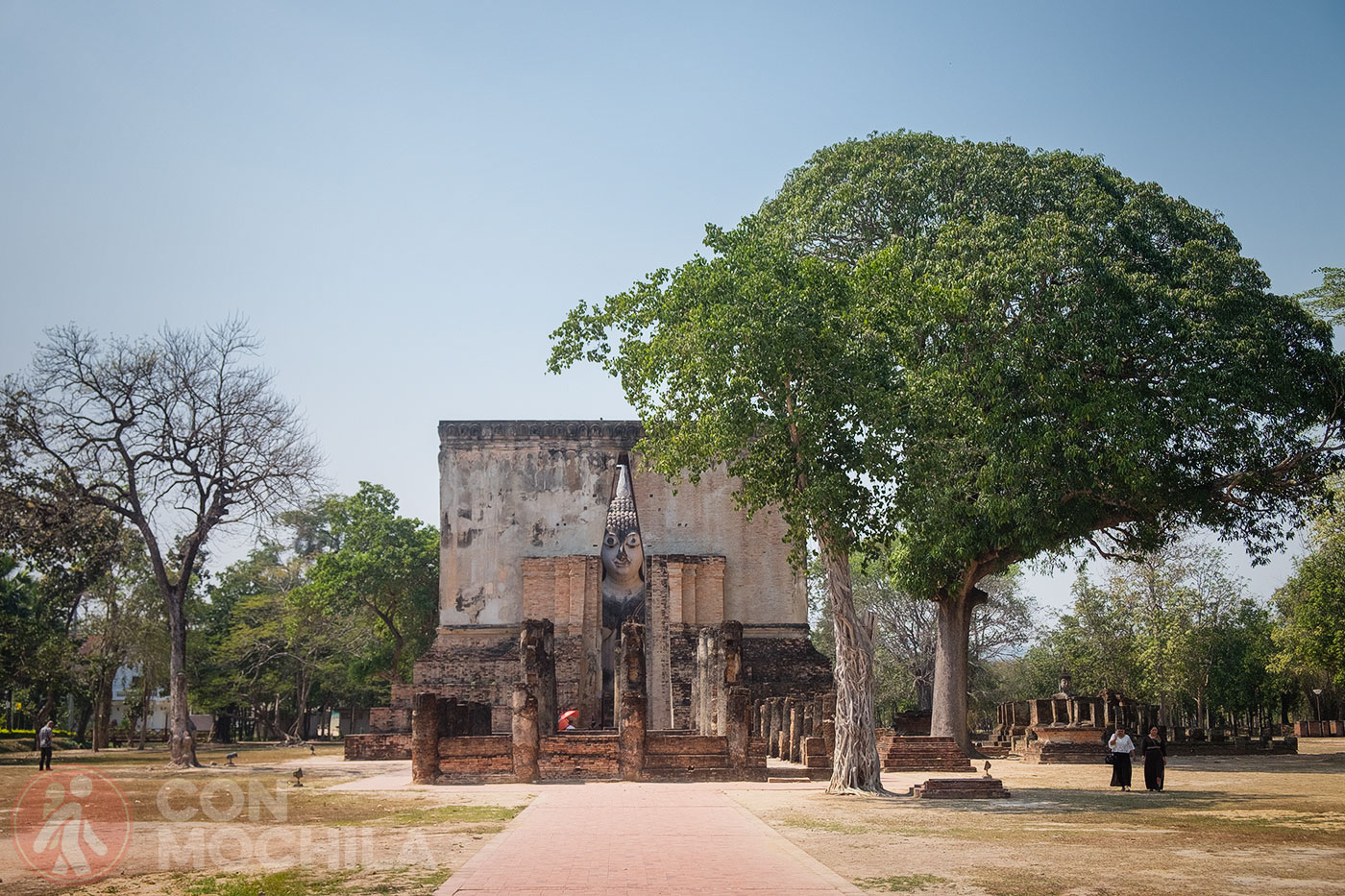
The origins of Wat Phra Phai Luang date back to the Khmer period, before the Sukhothai Kingdom. One of its columns still features depictions of scenes from the life of Buddha, along with images of Shiva and Brahma.
A couple of kilometers west of the old walled city is Wat Saphan Hin, a small hilltop temple with a large Buddha statue known as Phra Attharot.
In this part of Sukhothai, you can follow a path that leads to the remains of several temples and chedis, such as Wat Chang Rob, Wat Chedi Ngam, Wat Mangkorn, Wat Tuk, and Wat Si Thon, among others.
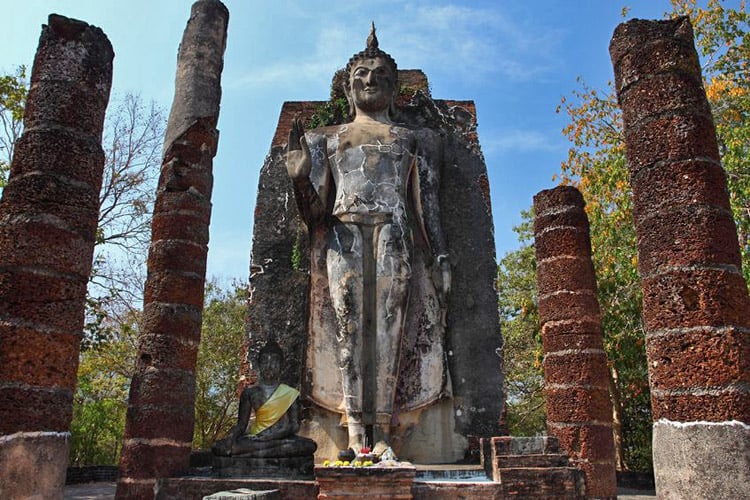
You can easily get there by bike, but the slight incline of the road will require a bit of effort when pedaling. The best part of this area is that it’s usually very quiet with few visitors around.
Finishing your tour around the walled area, you’ll come across Wat Chetuphon, the largest temple in the southern zone. The temple features a large viharn, several small chedis, and a couple of mandapas, one of which displays Buddha images in various postures.
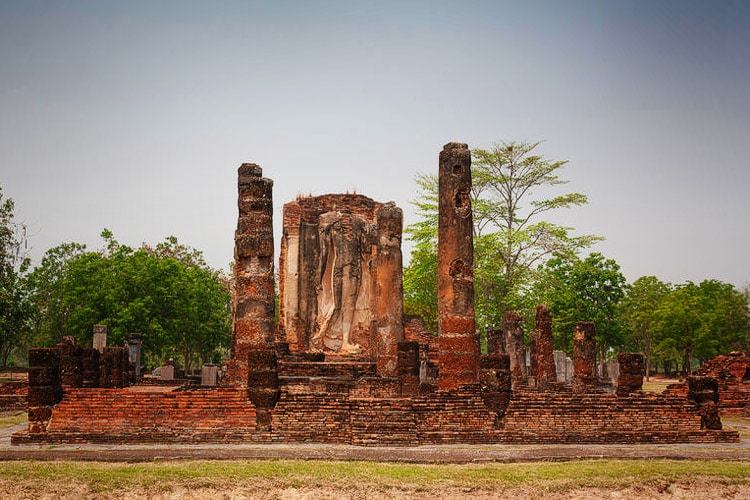
In this area, located a couple of kilometers from the south gate of the wall and accessible by bicycle, you can also visit Wat Kon Laeng, Wat Ton Chan, and Wat Chedi Si Hong.
The main activity in Sukhothai is undoubtedly visiting the temples within the historical park, and the most convenient way to do this is by bike. Many hotels offer bicycle rentals for guests.
If you prefer a guided experience, you can also book a full-day mountain bike tour of the temples and surrounding countryside. The choice is yours!
The cheapest hotels and guesthouses are usually located in the newer part of Sukhothai, while the more luxurious ones are near the historic center.
First of all, it’s important to know that Sukhothai is divided into two areas: the old area, where the walled Historical Park and temples are located, and the new area, where the current city is, about 12 kilometers away. To travel between the two, you can take a tuk-tuk (250/300 baht), a blue songthaew (20 baht, 20 minutes), or ride a motorbike if you’ve rented one.
There are several options for getting around the Historical Park. The most recommended, if it’s not a very hot month like March or April, is by bicycle. This allows you complete freedom of movement and offers a unique way to enjoy the park.
While some people think it’s too much, I can assure you it’s not that hard. Last time, my mother came along, and we cycled through the entire walled area and its surroundings. Bicycles are easy to rent nearby or at your accommodation, and they usually cost no more than 30-50 baht per day. Keep in mind that when entering the park, you’ll be charged an additional 10 baht for the bike.
Another option is to use a motorbike, which we did on our first visit. It offers the same independence as a bicycle without the effort of pedaling. Of course, you won’t get as much exercise with this option.
The most expensive option is to negotiate a price with a driver and go by tuk-tuk. This way, you’ll be driven everywhere without having to worry about navigating with a map.
Finally, you can also take the electric train that runs through the center of the Historical Park for about 40 baht.
Click on the image and it will take you to a new Google Maps window with all the points of interest to travel around Sukhothai.